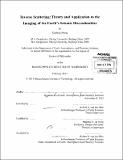Inverse scattering : theory and application to the imaging of the Earth's seismic discontinuities
Author(s)
Shang, Xuefeng, Ph. D. Massachusetts Institute of Technology
DownloadFull printable version (19.43Mb)
Other Contributors
Massachusetts Institute of Technology. Department of Earth, Atmospheric, and Planetary Sciences.
Advisor
Robert D. van der Hilst and Maarten V. de Hoop.
Terms of use
Metadata
Show full item recordAbstract
In this thesis we further develop concepts in inverse scattering, which enable higher resolution imaging with data from dense networks and arrays. We apply the new methods to studies of the crust beneath south Tibet and the core-mantle boundary (CMB) region beneath Central America and East Asia. First, we develop a new method, which we call passive source reverse time migration (RTM), for subsurface imaging with teleseismic array data. Multi-component array data are first propagated backward by solving the elastic wave equation. After polarization separation, a modified cross-correlation imaging condition between P and S wave constitutes is applied to obtain an inverse scattering transform. From synthetic experiments it is evident that for complex geological structures RTM is superior to traditional receiver functions analysis, such as common conversion point (CCP) stacking. Two preprocessing steps are required for RTM application on sparsely sampled teleseismic dataset: source normalization and trace interpolation. The source radiation pattern, especially the polarity of traces, is corrected by multi-channel cross-correlation technique. The unknown source signature is then estimated by principle component analysis and deconvolved from raw data by Wiener deconvolution. Curvelet interpolation with sparsity promotion is employed to interpolate irregularly and sparsely sampled traces into regular and dense grids. Synthetic and real data examples demonstrate that for typical teleseismic acquisition geometry, with 50% to 85% missing traces, the curvelet-based interpolation works remarkably well. The application on Hi-CLIMB array data in Tibetan plateau reveals clear and continuous Moho discontinuity at the depth of about 70 km, as well as fine crustal structures. Second, we use a high-frequency approximation of inverse scattering, generalized Radon transform (GRT), to probe the lowermost mantle beneath Central America and East Asia. Inverse scattering of about 130,000 ScS traces and 120,000 SKKS traces reveals multiple reflectors above the conventional D" region. This result is inconsistent with expectations from a pure thermal response of a single isochemical post-perovskite transition but can be explained with post-perovskite transitions in differentiated slab materials. Our results imply that the lowennost mantle is more complex than hitherto thought and that the presence of interfaces and compositional heterogeneity beyond the D" region.
Description
Thesis: Ph. D., Massachusetts Institute of Technology, Department of Earth, Atmospheric, and Planetary Sciences, 2014. Cataloged from PDF version of thesis. Includes bibliographical references.
Date issued
2014Department
Massachusetts Institute of Technology. Department of Earth, Atmospheric, and Planetary SciencesPublisher
Massachusetts Institute of Technology
Keywords
Earth, Atmospheric, and Planetary Sciences.